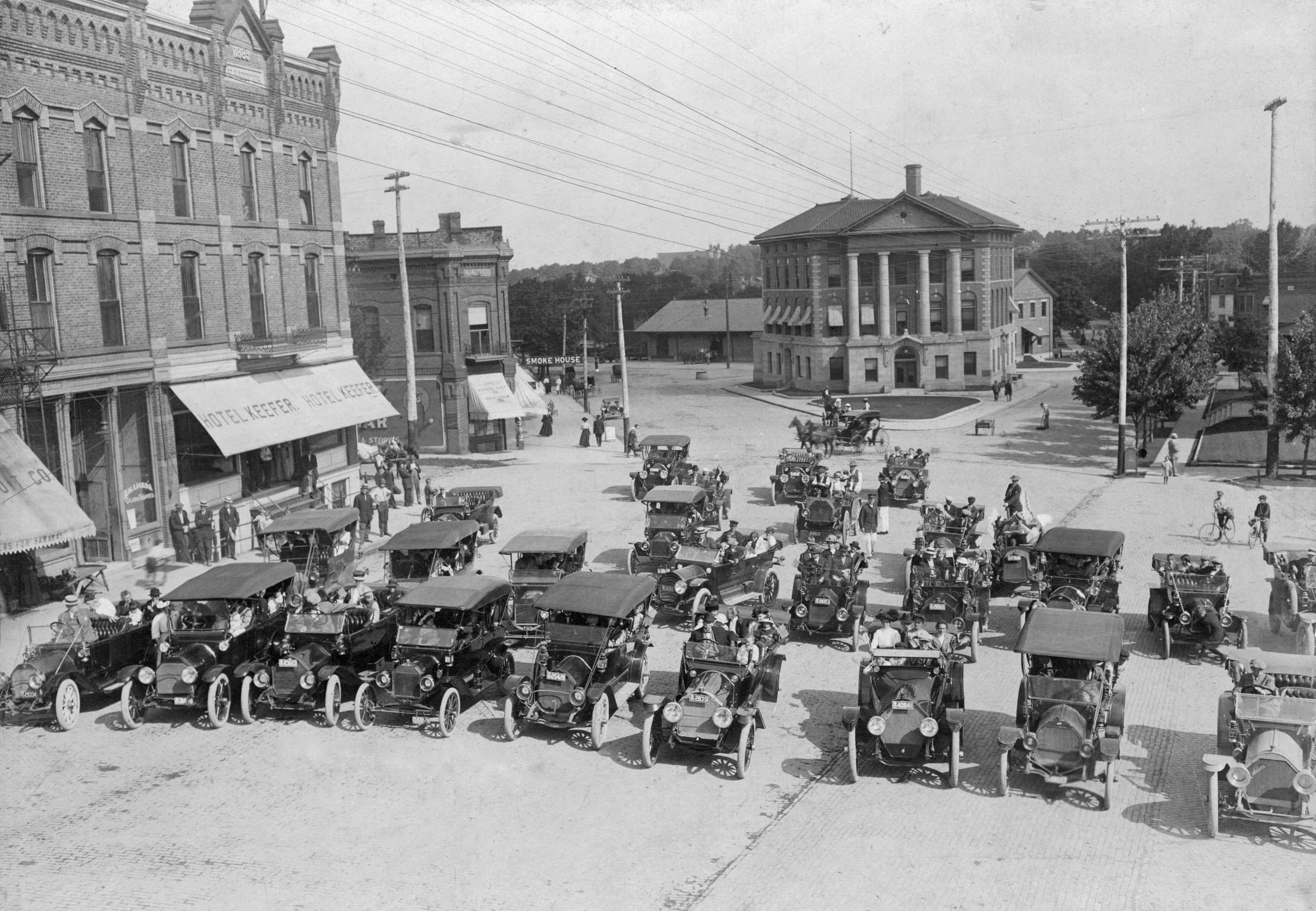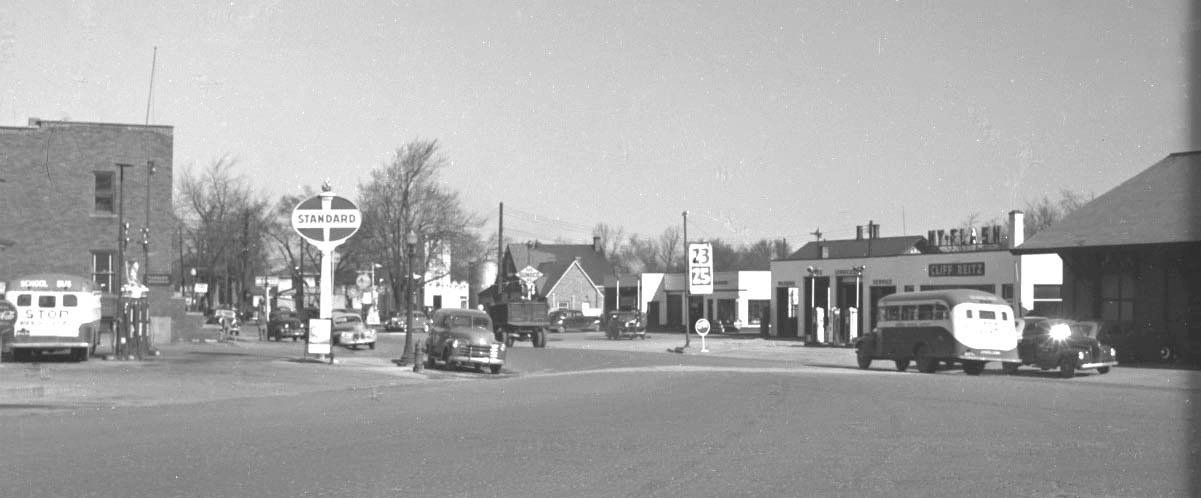Autobuggies Come to Hillsdale County
On October 3, 1899, the first “horseless carriage” roared through Hillsdale at 15 mph and caused quite a stir. It was inevitable that the newspaper would soon be warning “autoists” that “accidents to pedestrians and people in carriages are very possible.” The blazing speed must have given quite a rush to the drivers, who had to adjust to the requirements of steering a piece of metal that didn’t have the awareness of its surroundings. Soon other autos took to the road and, predictably, two of them ran into each other.
One of the first manufacturers of autos in Hillsdale County was The Deal Buggy Company. Originally a blacksmith, Jacob Deal came to Jonesville in 1858. In 1865 he sold his smithy and erected two small buildings on West Street. There he began to manufacture wagons and buggies. Eventually he employed over 100 men, turning out more than 4,000 high grade buggies each year. His son, George, joined the company in 1891, and J.J. Deal and Son turned to horseless carriages when the demand for buggies declined.
George’s enthusiasm for the new horse-less carriages, specifically delivery trucks, led to the company assembling “autobuggies.” These evolved into the Deal automobile in 1908. George died suddenly later that year, and without his leadership the company went out of business in 1915. Two Deal cars still exist, one in Grand Rapids with a private owner and one in the window of the Jonesville City Hall. Another reminder of George remains in the lovely home on Maumee Street he built. It became the Manor Foundation and is now owned by a family that has made a comfortable home without losing its historic look.
Pinkham and Wright went into business when automobiles far outnumbered wagons and carriages. The men set up shop originally on Broad Street. There they employed men to assemble Ford autos that were shipped in component parts. In various automobile businesses, the men worked in teams, sometimes challenging other teams to see who could get their car up and running the fastest.
Finding great success with their business, Pinkham and Wright moved their premises to Railroad Street (which became Carleton Road). It was one of many businesses replacing the warehouses and liveries that originally lined the railroad tracks. They outgrew the building, but when they first proposed to City Council that they build a larger “garage building” on McCollum Street for their expanding business, they met firm opposition because the area was residential, with Manning Street boasting some of the most beautiful homes in Hillsdale. The spot that Pinkham and Wright wanted for their business had previously been a livery. Apparently the reek of horses and their poop were acceptable, but the idea of autos being built there was too much.
By September 1919 sentiments changed, and Pinkham and Wright built a large brick building (which later became Montgomery Ward and then the Mid-Town Building). The second floor of their business was called a dance hall, but held many public functions. The most memorable (at least to the children involved) was a clinic held by the Health Department, where scores of tonsils were removed with the efficiency of the automobile assembly of the first Pinkham and Wright company workers.
Around Hillsdale County livery stables were gradually replaced by bicycle, machine and automobile shops. Bentz Brothers offered all three services. As with Pinkham and Wright, as well as the Leutheuser Company in Somerset, men were employed to put automobiles together with, occasionally, the competitions that enlivened things as they raced to determine which crew could assemble a (working) car first.
With faster transportation came the desire for better roads. The first county road commission was organized on Oct. 24, 1919. It adopted the first county road system the next month from a map drawn by the first county engineer, Dewitt Dudley. Working 10-hour days, laborers were paid 30 cents an hour, while men with teams received 60 cents per hour. Picks, shovels, horse power and backbreaking effort provided the basis for the road system we have in Hillsdale County today.
The county roads were generally spaced about four miles apart and connected the small towns in the county. Townships were responsible for all other roads until 1935 when the McNitt Act became law in Michi-gan. The County Road Commission then became responsible for all roads except for state highways and town streets.
The first road paved in the county was M-99 (also named M-64) between Hillsdale and Jonesville in 1924. Bankers and State roads followed in 1935. A county garage was built in Hillsdale down the hill from the county courthouse, with four satellite garages built in the early 1930s in Camden, Litchfield, Jerome and Waldron. In 1973 the road commission constructed a new office on the corner of M-99 and Steamburg Road in Cambria Township, where it was very close to the exact center of the county.
As cars replaced horses, gas stations replaced liveries. Free-standing filling stations served as a social center for men. First published in November 1918, the comic strip “Gasoline Alley” became a forum for conversations about automobiles between Doc, Walt, Avery and Bill. In Hillsdale the cluster of stations on Carleton Road at the end of Broad Street earned the name of Gasoline Alley too. Many of the dealerships also had gas pumps in front of them.
Until the 1960s, getting gas for your car was vastly different from what it is today. The customer pulled up to the pump and sat there like royalty as an attendant filled the car’s gas tank. With the first gas stations that was quite a production. The gasoline pumps had a glass globe on top with a gravity feed. After the customer told the attendant how much gas they wanted, the attendant pushed and pulled the crank on the pump to draw gas into the globe until it reached the line that matched the number of gallons desired. Then a hose attached to the globe was placed in the car’s gas tank and gravity did the rest.
By the early 1950s a mechanized pressure device inside the pump made getting gas easier, but the attendants continued to fill the tank, check the oil level and wash the windows. Not even close to the convenience stores that we find today at gas stations, items available for sale were limited to tobacco products, candy bars and an ice-filled cooler of Coke and Nehi beverages.
Today we have cars built with computerized inner workings so complex that mechanics are guided by a program to diagnose and correct a problem. At self-service gas stations we get our own gas, pay at the pump and then go into the store to get snacks or buy a lottery ticket. Our roads—at least theoretically—are smooth going. It’s a challenge to think about the amazement that must have accompanied the changing over from the power of a horse to horsepower.
JoAnne P. Miller








